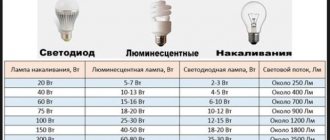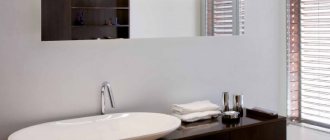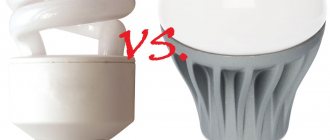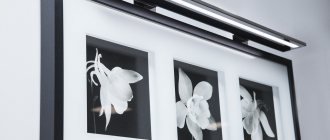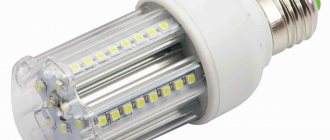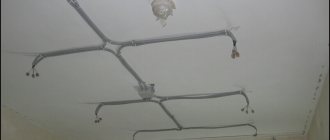Determining the lighting level
It is known that vision problems, loss of energy and constant migraines can occur due to poor lighting in the room.
The lack of light also negatively affects a person’s psychological state, so calculating the lighting level is the most important step in the process of choosing a lamp.
There are a lot of programs on the Internet that allow you to calculate an indicator acceptable for a particular room, for example Dialux. However, you can calculate the lighting level manually using a special formula.
This formula is based on the ratio of the total luminous flux of lighting devices and the area of the room, taking into account the correction factor.
The calculation looks like this: E (lx) = F (lm) / S (sq. m) × η, where:
- the calculated indicator E represents the level of illumination of the room, calculated in Lux;
- F is brightness measured in Lumens (you can find its value on the packaging);
- S – area of the room for which the calculation is being made;
- η is a correction factor that reflects the proportion of light reaching from the lighting device to the working surface.
A correction factor is necessary to make the calculation more accurate.
Otherwise, the formula will not take into account the fact that not all the light from the lighting device reaches the target, but is partially scattered, falling on the walls, ceiling or furnishings.
The average value of this indicator is 0.5.
The indicator obtained during the calculation process must be compared with the standards for indoor lighting, which are prescribed in special standards.
In particular, the indicative figures are indicated in SanPiN 2.21/2.1.1/1278-03 “Hygienic requirements for natural, artificial and combined lighting of residential and public buildings”, as well as in SP 52.13330.2011 “Natural and artificial lighting”.
According to them, the lighting level must comply with the following standards depending on the type of room:
- bedroom and living room – up to 150 lux;
- children's room - 200 lux;
- office or room intended for reading – 300 lux;
- bathroom, toilet – 50 lux.
As for office premises with computer equipment installed in them, according to the standards, the lighting level in them should be about 400 lux.
However, it is also permissible to use lamps with higher brightness, because most manufacturers indicate on the packaging not accurate, but inflated data regarding the value of the luminous flux.
How to choose the right lamp - what do you need to know?
- To create a working atmosphere in offices, you should use general and individual lamps with a glow temperature of 4000-4500K. In staff rest areas, it is better to install warm light lamps at 2000-2500K.
- In stores, it is recommended to use combined lighting - ceiling lamps for general lighting, accent lighting to highlight individual products and illuminated display cases.
- It is best to equip open-type warehouses with spotlights on lighting masts and lamps on ropes stretched over the warehouse territory. In closed warehouses, general lighting should be supplemented with local lamps with motion sensors.
- Street lighting fixtures must be protected from moisture, temperature changes and vandalism.
Organization of lighting zones and power selection
Before moving directly to choosing a lamp, you need to think about the design of the lighting area.
If you think in time about for what specific purposes this or that lighting device is needed, you will be able to avoid mistakes.
Design project by Kiril Ognenov
If you want to decorate any area in the apartment with the help of light, then you need to think through its design down to the smallest detail from the very beginning. In this case, both the color of the walls and accent furnishings will be important.
For example, if you hang a picture on the wall in a sitting corner, it would be advisable to highlight it with light.
And in this case, the lighting should be as soft as possible, not irritating the eye, and the color of the sconce should not contrast with the shade of the walls.
Then the area highlighted with the help of proper lighting will look organic, both on its own and in the general space of the apartment.
As for power, here it is also necessary to proceed from the tasks that need to be solved with the help of lighting. For example, the lamp power in the workplace should not be higher than 60 W.
On the one hand, high values of this indicator guarantee increased brightness of the light, on the other hand, such lighting can negatively affect a person’s well-being during long and intense work.
To decorate a small workspace, it is advisable to choose lamps with soft, diffused light that will not strain the eyes.
It is better if it is lighting as close as possible to daylight. Larger work surfaces will require more powerful lighting fixtures, but the degree of incandescence must be taken into account.
When designing a work area, it is also important how the lamp will be installed. In this case, the lamp should not peek out from under the lampshade or be at eye level.
Problems
Cons of chandeliers
- difficult installation;
- requires careful care;
- low security;
- large product sizes.
Problems with LED devices
- fragility;
- unpleasant spectrum of light;
- large in size;
- Operation requires expensive power supplies and cooling systems.
Cons of floor lamps
- illuminate a small space;
- potential flammability;
- there is no way to hide the wiring;
- dependence of the device on the outlet.
Disadvantages of sconces
- not used for main lighting;
- there is no way to hide the wiring;
- small luminous flux;
- Potential flammability.
Cons of floodlights
- difficulty in operation;
- burn out from overheating;
- high frequency flicker;
- high price.
Disadvantages of low-voltage lamps
- limited functionality;
- sensitivity to power outages;
- fragility.
Cons of night lights
- dim lighting;
- low color intensity;
- cannot be used as main lighting.
Disadvantages of busbars
- limited functionality;
- electrical current instability.
Selecting the size and design of the lamp
When choosing a lamp, both the size and design features of the lighting device are important. And here you need to take into account various nuances.
So, if the ceilings in the room are not too high, then it is better to abandon the use of an oversized high chandelier, replacing it with flat models of ceiling lamps.
Design project ARTEХ
At the same time, even a flat lamp should not be too small, otherwise it will not only not fully fulfill its lighting functions, but will also look awkward in the space of the room, making the interior unbalanced.
As for the placement of lamps in height, the average height above the floor should be 200-220 cm, the height of the lampshade above the table surface should not be less than 70 cm or exceed 90 cm.
What is the warranty for lamps?
The warranty period for lamps is 18 months, unless otherwise specified in the device passport.
The warranty does not apply to goods in the following cases:
- in case of violation of storage and operation rules;
- installation or repair was carried out by unqualified specialists;
- lighting equipment was connected to a network with inappropriate voltage;
- the user handled the device carelessly;
- traces of mechanical damage or changes to the design of the device are visible;
- if incorrect color rendition was noticed during operation of the equipment.
The warranty covers repairs, replacement of parts or complete exchange of goods. Batteries, starters and other power supplies, as well as additional accessories are not covered by the warranty.
Presentation of the passport for the purchased product and the warranty card is required.
Selection of light bulbs
It is the type of lamp that determines how the lighting in the room will look. There are four types of lamps in total.
Incandescent lamp
This classic option has been used for lighting apartments for decades and has still not lost its relevance.
The light that comes from incandescent lamps is soft and warm, creating a cozy environment.
Compact fluorescent lamps (CFLs)
This option can be considered economical, because such lamps consume 75% less energy than traditional incandescent lamps.
In addition, they have an increased service life and cooler light. However, due to the mercury content, this lighting option requires careful handling and proper disposal.
LEDs
No less effective than the previous option, but their service life is three times longer.
They provide direct and too harsh light, therefore they are mainly suitable for workplace equipment.
Halogen
Another economical and bright option, consuming 15% less energy than incandescent lamps.
They emit white light, reminiscent of daylight. Suitable for equipping workplaces.
How to choose a lamp for a store
Lighting in a store helps customers navigate the retail space and attracts them to the right product groups. For this purpose, combined lighting is used - general and accent.
The choice of general lighting for a store determines the visual comfort for visitors. According to standards, store illumination should range from 300 lux for non-self-service areas to 500 lux for supermarkets. For general light, pendant or built-in lamps with a wide dispersion angle of 120° and above are used.
General lighting pendant lights are placed evenly over the entire ceiling area.
The optimal luminous temperature of such lamps for a store lies in the range from 3000 to 4000 Kelvin. 3000K is more suitable for a home environment and is suitable for stores with a small sales area - clothing boutiques or cosmetics stores. 4000K - suitable for lighting large areas of super and hypermarkets.
Accent lighting allows you to draw customers' attention to the desired department, display case or individual product. This type of lighting is especially relevant for fashion boutiques, jewelry stores and furniture stores.
To set up accent light, recessed and rotating spots, track lamps with a narrow dispersion angle are used. The temperature of the glow is selected according to the type of product - diamond pendants and rings are favorably emphasized by the bright cold light of 6000K, and fashionable dresses or suits look good in the rays of warm light of 2000K.
Advice!
An unusual design move would be to replace traditional white light with colored light - red, green or blue. The main thing is to observe moderation and highlight one or two interior details with a bright shade.
A separate type of accent lighting is display lighting. It is relevant when there are not enough other sources to sufficiently illuminate the goods laid out behind the glass.
Jewelry is brightly illuminated by LED strips built into the display cases.
For illuminating shop windows, LED strips and linear lamps will be a balanced solution. They provide even light over a large area and can be discreetly installed in shop window frames.
Appearance of light = Kelvin
When choosing a lamp, you need to consider not only its brightness, but also the color temperature of the light, which is measured in Kelvin and ranges from warm to cool.
Information about this characteristic can usually be found on the packaging. The higher the Kelvin value, the colder the light.
Soft white/warm white
The value in Kelvin is about 2,700. This light is more suitable for a living room or bedroom, where a cozy environment is of great importance.
Bright white/cool white
The value in Kelvin is early 4,100. This light will best fit into the interior of a kitchen, bathroom, or toilet.
Daylight
The value in Kelvin can vary between 5,000-6,000.
This light is more suitable for the dining room, kitchen, basement, library, study, where the maximum level of lighting is required.
Main types of ceiling lamps
If you are planning to renovate your apartment, pay special attention to the ceiling. This is a real field for creativity: you can come up with an interesting, original and functional lighting solution and create a special atmosphere in any room.
To do this, you can use different types of ceiling lamps according to the installation method:
- surface installation;
- hanging;
- built-in;
- mortise;
- point;
- invoices;
- rotary.
Take the test
Or the type of lamps used:
- halogen;
- LED;
- fluorescent (energy saving lamps);
- incandescent;
- raster.
To decorate the bedroom and living room, the most commonly used types of ceiling lamps are surface-mounted, pendant or recessed.
Surface ceiling fixtures vary in shape:
- square (round);
- oblong (oval).
The installation locations of the lamps are carefully thought out and determined in advance. In order for different areas of the room to be illuminated sufficiently brightly at the same time, it is possible to provide for the installation of several light sources in different parts of the ceiling.
Ceiling lighting fixtures vary in the number of lamps: single-lamp and with several light sources.
Types of ceiling lamps according to the principle of light distribution:
- scattered;
- directed;
- reflected.
Recessed ceiling lighting sources can be directional (the direction of the light flux cannot be adjusted) or have a rotating design (the direction of the light flux can be adjusted).
Defining the lighting task
To choose the right lamp, you need to determine what type of lighting is required in a particular area of the room.
General or ambient lighting
This lighting is also called ambient lighting. Its main task is to uniformly provide light to the entire area of the room.
The most commonly used ambient lighting is ceiling-mounted lighting fixtures, such as chandeliers.
Work lighting
This type of lighting is necessary for arranging a workplace, for example, a computer desk, kitchen surfaces, or a sewing machine.
For these purposes, table or floor lamps are most often used, in which the angle of incidence of the light can be adjusted.
Design project from We Are Huntly Studio
Accent lighting
It is used to highlight individual objects in the interior, as well as for lighting in corridors, staircases, and hallways.
Wall lamps (sconces) are used as accent lighting fixtures.
There are also local and decorative lighting. The first is intended for zoning space and highlighting a separate zone in the room.
The second is temporary and is used as additional festive decoration of the room (garlands).
What functions do lamps perform?
They serve so that they can be installed on the ceiling. In this case, there can be both spotlights for ceilings and more luxurious models. For example, crystal or wood.
Ceiling lamps can vary in design, materials, number of bulbs, beam intensity and many other features.
They are used to transmit light in a supermarket, office space, apartment and other places. In addition, they can be used to decorate street courtyards or facades.
Types of lamps
Before choosing a lamp, it is useful to know what types of lighting fixtures exist.
According to their design, lamps are divided into floor and table lamps.
Floor lamps
Floor lamps include a floor lamp, which is a universal lighting device for various types of rooms.
It is used not only for local illumination of any area in the room, but also as a decorative element.
Floor lighting fixtures can have a variety of designs, but most often they are made in the form of a lampshade on a high leg.
At the same time, in modern models the height and position of the leg can be adjusted, and the lampshade can be removed, which is very convenient.
Moreover, such a device does not require complex installation, but it is only suitable for highlighting individual zones.
Table lamps
Table lamps are mobile and compact portable structures on a leg with the ability to adjust the tilt, characterized by ease of use and low cost.
They are divided into working and decorative, and depending on the purpose, a number of corresponding requirements are put forward for such devices.
Pendant lamps
Ceiling lamps are classified as hanging fixtures. They are designed to highlight individual work areas and zoning space.
They can also be mounted at different heights.
Wall lights
Wall lamps include sconces that are mounted on the wall.
Most often they are used for accent lighting or highlighting individual areas in a large space.
Recessed luminaires
It most often includes spotlights (spots).
They are small lighting fixtures with directional light propagating at a certain angle and can be used in any room as an additional light source.
Advantages
Benefits of chandeliers
- completely illuminate the room;
- variety of designs;
- comfortable color rendering;
- durability with proper use;
- will add luxury and elegance to the interior.
Advantages of LED lamps
- choice of color temperature;
- light brightness control;
- environmental cleanliness;
- colored decorative lighting;
- compactness and flexibility of modules.
Advantages of floor lamps
- mobility;
- energy saving;
- possibility of using directional light;
- ease of use;
- devices can be carried;
- suitable for different styles.
Pros of sconces
- creating illumination of decorative elements and background lighting;
- possibility of zoning space;
- wide range of applications;
- small sizes;
- ease of installation and use.
Advantages of floodlights
- long term;
- high brightness;
- resistance to mechanical damage;
- low energy consumption;
- possibility of creating directional light.
Advantages of low-voltage lamps
- environmental Safety;
- ease of use and disposal;
- operation does not require a DC source;
- made of durable materials (aluminum, polycarbonate);
- possibility of using directional light.
Benefits of night lights
- used to create emergency light in rooms;
- original design and interesting shapes of devices for children;
- possibility of transportation;
- compactness;
- ease of use.
Advantages of busbars
- anti-corrosion properties;
- wear resistance;
- possibility of changing the direction of light;
- durability.
Lighting for every room
When choosing a lamp, the type of room is no less important.
Bedroom
You should pay attention to pendant and ceiling fixtures, as well as additional lighting sources in the form of a wall sconce or a table lamp that can be placed on the bedside table.
Kitchen
In the kitchen area, not only ambient lighting is important, but also illumination of work surfaces and the dining area.
Lampshades, sconces, and built-in lamps are suitable for these purposes.
Living room
In a living room or hall you cannot do without a classic ceiling chandelier, designed for at least five lamps.
And as additional lighting, you can use accent light, for example, to highlight a painting or any designated area in the room.
Bathroom
Bathroom lighting can be quite complex and can involve different types of fixtures depending on the size of the room and its design.
However, there is one important rule: the mirror should be illuminated as much as possible on both sides.
Design project from Chango & Co
So, how to choose a lamp? You need to approach the choice of lighting in your home wisely, but at the same time creatively.
Sometimes the most unexpected lamp options fit perfectly into the interior and become its brightest element.
Therefore, when choosing a lighting device, you need to focus not only on the rules, but also on the general style of the room and your own preferences.
How they work
The lamp consists of a lamp and auxiliary elements that drive the mechanism: a starter and a throttle.
- The starter is a neon lamp with two bimetallic electrodes. Voltage is applied to the lamp, a discharge is formed in it, after which the starter elements are closed. A strong current passes between the lamp bulb and the starter electrodes.
Then the electrodes open the system, and the voltage increases sharply through the inductor. Under the influence of voltage, the gas gap in the light bulb breaks through and it lights up.
- The choke is connected to the lamp in series, so the voltage is divided into both elements, the starter is connected in parallel, so the voltage is not enough to re-close the starter electrodes.
The choke limits the current after turning on the device and maintains stable operation of the lamp.

